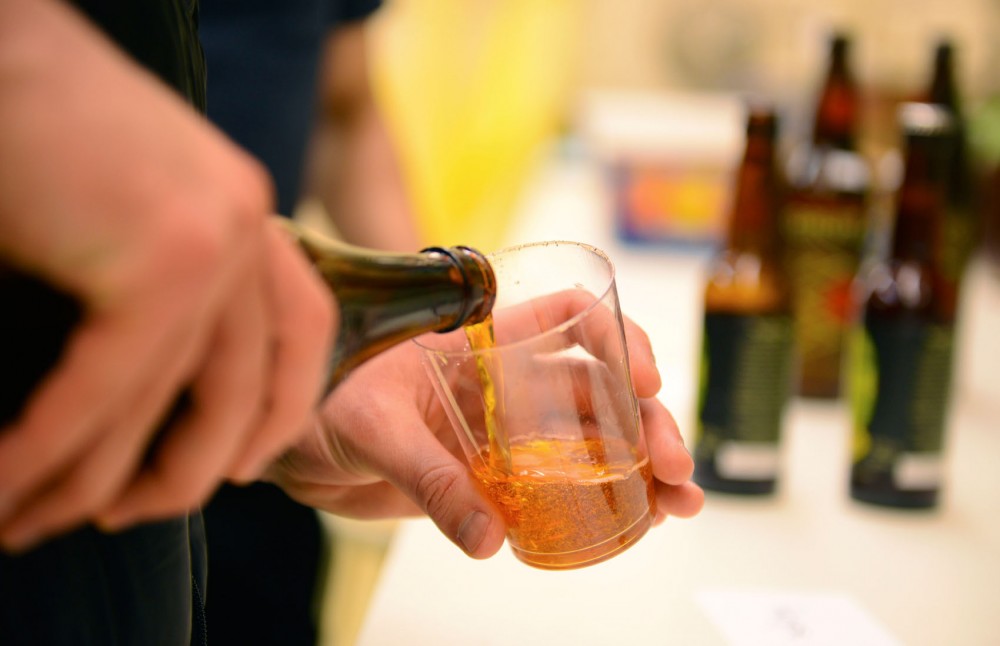Biochemistry senior Danielle Harding is surrounded by home brewers.
Her friends, her boyfriend and even her father brew their own beer, so it comes as no surprise that she’s taken an interest in it as well — though hers is scientific.
Harding is the president of the University of Minnesota Biochemistry Club, which is putting on its first home brewing seminar Friday to explain the science behind brewing beer. Harding said the club created the seminar to cater to the growing number of students and faculty who are interested in learning how to make their own brews.
“I have family members and friends who have been brewing beer for quite a while now, and none of them have any real background in the biological sciences,” she said. “But … I noticed that it had a lot to do with biology and yeast and things I’ve learned about in my biological science classes.”
She said seminar attendees will not only learn about the brewing process but also the science behind it, including reasons for using different types of yeast and why alcoholic content varies among beers.
While Harding doesn’t brew herself, she said the process can be enjoyable purely from a scientific view — for example, she’s interested in the different yeast strains used in brewing.
“Being a biochemistry major … I’ve had a lot of experience in yeast and growing yeast in different labs,” she said. “That really piqued my interest.”
Biology professor Jim Cotner will speak at Friday’s seminar. He said he started home brewing 12 years ago because he couldn’t find good beer in Texas, where he taught at the time.
Now Cotner teaches the University’s first brewing class — Brewing: The Biology, History, and Practice.
In the class, students learn the brewing process and the science behind it, such as how seed germination produces enzymes that convert the barley into sugar or what the correct temperature is to add yeast to a batch without killing it.
In the lab, Cotner said, students get to test out what they’ve learned by brewing and then sampling their own beers.
“When they’re making beer, it’s pretty cool,” he said. “They’re brewing the pots, and it smells really awesome in there — even the next day you can smell it.”
For field trips, the students visit breweries and other industry establishments. Cotner’s favorite tour so far was a malting facility in Shakopee, Minn., he said.
“That’s where they convert the grain so you can get sugar out of it,” he said — an essential, but lesser-known part of the brewing process.
This semester’s class filled up in three days, Cotner said, but it’s unlikely that he’ll be teaching the course every semester, because he has to get back to his “real job” — studying lakes.
Biochemistry junior Christopher Basting said he started brewing beer a year ago, about the same time he joined the Biochemistry Club.
“It seemed like a cool hobby,” he said. “It was kind of cool to actually kind of do a science experiment that yielded some drinkable beer.”
He typically brews about 5 gallons per batch, he said, which rounds out to about 50 bottles of beer.
He said understanding brewing on a molecular level makes the process extra-interesting.
But the biggest lesson someone can take from applying lab work to brewing is how to avoid contaminating an experiment, Basting said.
“I found out that most of what I’ve learned in class and in labs is how to be sanitary,” he said. “Sanitation is really key in brewing.”
Tapping into the local economy
Third-year law student Dominick Grande has been brewing for four years and is part of the West Bank Brewing Association, a student group that he said originally aimed to influence Minnesota brewing laws.
The association wanted to curb restrictions for smaller breweries so they could compete with larger ones, he said.
In 2011, Minnesota amended liquor licensing policies to allow small breweries to sell beer onsite — legislation often referred to as the “Surly bill,” after Surly Brewing Company.
Now, brewers producing fewer than 250,000 barrels of malt liquor annually can get special licenses to sell directly to customers onsite, which Grande said makes them much more money.
While this doesn’t put breweries like Surly in the running with national chains, he said, small local brewers now have a fighting chance.
“It’s easier to get started,” he said. “Volume was a huge advantage, and it was very difficult to compete with that.”


